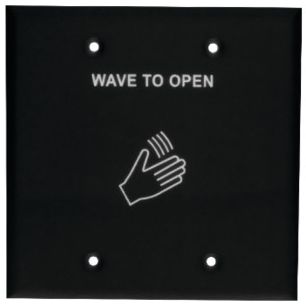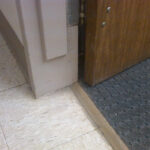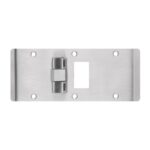If you’ve been reading iDigHardware for a while, you know how much I love to receive questions that I haven’t thought about before (my excitement is a little embarrassing, actually). Last week, I received a question about low-energy automatic operators and the need for them to be actuated by a “knowing act.” There is a lot of information in the article I wrote for Doors & Hardware on this topic, but last week’s question was this:
 If a low-energy operator is actuated by a motion sensor, it has to meet the requirements of A156.10 instead of A156.19, which usually means the door must have guide rails and safety sensors. What about the “wave-to-open” switches…are these considered motion sensors?
If a low-energy operator is actuated by a motion sensor, it has to meet the requirements of A156.10 instead of A156.19, which usually means the door must have guide rails and safety sensors. What about the “wave-to-open” switches…are these considered motion sensors?
These actuators may be designated “touchless,” “hands-free,” or a similar term in the manufacturers’ catalogs, but the A156.19 standard calls them “fixed non-contact switches.” These switches are one of the methods defined by BHMA as a knowing act:
2.1 Knowing Act: Consciously initiating the powered opening of a low-energy door using acceptable methods including: wall or jamb-mounted contact switches such as push plates; fixed non-contact switches; the action of manual opening (pushing or pulling) a door; and controlled access devices such as keypads, card readers, and keyswitches.
A156.19 goes on to describe the acceptable range for actuation of these switches (great job BHMA!):
Fixed non-contact switches should have a detection range no greater than 12 in. (305mm) to ensure a knowing act is utilized to activate the door.
In summary, touchless switches for automatic operators are considered a knowing act, but the detection range (the distance from the waving hand to the switch) should be no more than 12 inches. Another hardware mystery solved!
You need to login or register to bookmark/favorite this content.






We have installed one pair of these non contact switches on a dual egress opening. The area has a designated clean and dirty side in the facility and eliminating the touch helped with a contamination issue as now employees from either side no longer touch the plate and share germs.
Great application!
– Lori
In addition to Lori’s excellent article on Fixed Non-Contact Switches A156.19 provides information relating to distance and location of the switch from the door. If it’s located more than 5 feet from the center of the door, an additional time delay beyond the minimum is recommended. Adding one second of time delay for each additional foot of distance is the requirement.
The time delay requirement mandates the Low Energy door operator, when powered open, to remain at the fully open position for a minimum of 5 seconds. Additional time delay per the distance rule as described above.
The location requirement should be a minimum of 34 to maximum of 48 inches from the floor or as specified by the local building code.